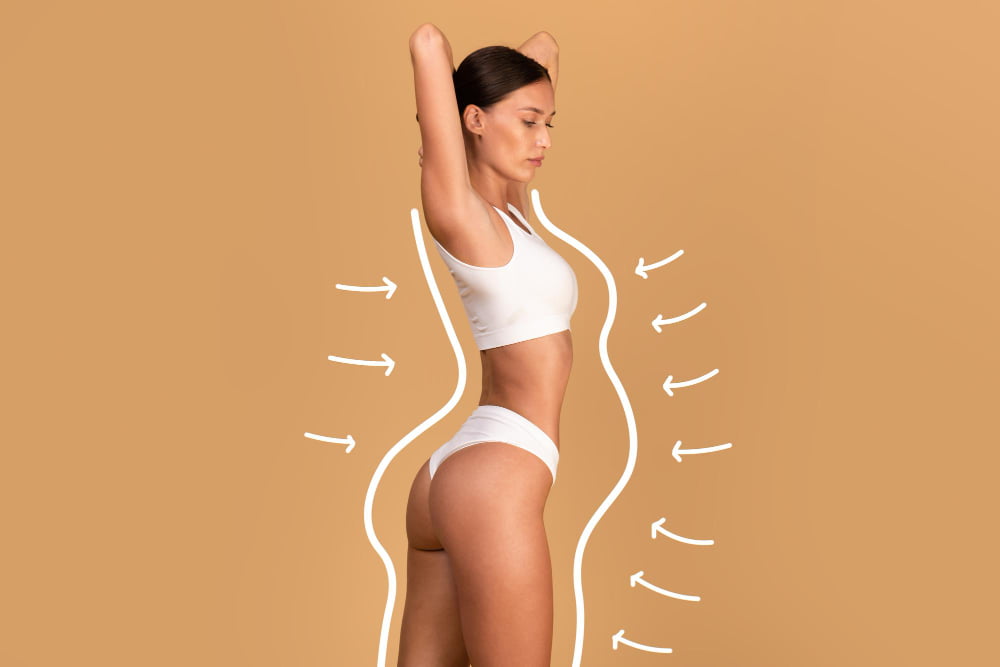Body Fat Calculator

Curious about your body fat percentage and how it affects your health? Well, you’ve come to the right place! This article will introduce you to the concept of body fat and its implications for your well-being.
We’ll explore the different types of body fat, how to calculate your body fat percentage using a body fat calculator, and the potential health risks associated with excessive body fat.
Get ready to learn more about your body and achieve a healthy body fat percentage.
Key Takeaways
- Body fat is composed of essential and storage fat, with essential fat being necessary for reproductive and hormonal functions.
- Calculating body fat percentage can be done using a body fat percentage calculator, but it’s important to consult a doctor for accurate assessment.
- Body fat percentage ranges vary based on gender and fitness level, with recommended ranges for essential fat, athletes, fitness, and average individuals.
- Excessive body fat can lead to various health problems, including heart diseases, diabetes, hormonal issues, and pregnancy complications.
Calculating Body Fat
To calculate your body fat percentage, you can use a body fat calculator as a rough estimate, but it’s recommended to consult a doctor for a more accurate assessment.
A body fat calculator is a useful tool that can provide you with an estimate of your body fat percentage based on your age, gender, weight, and height. It uses a formula that takes into account these variables to calculate your body fat percentage.
However, it’s important to note that the accuracy of these calculators can vary, and a medical professional will be able to provide you with a more precise measurement.
Additionally, there are other methods available to measure body fat, such as underwater weighing, skinfold method, BMI-based formulas, and ultrasound. These methods may provide more accurate results but may require specialized equipment or professional assistance.
Now that you know how to calculate your body fat percentage, let’s explore the normal ranges and implications of body fat percentage on your health.
Body Fat Percentage and Normal Ranges
Compare your body fat percentage with recommended values for a better understanding of your body composition. Here are five important points to consider:
- Use a body fat percentage calculator to determine your body fat percentage accurately.
- Men generally have a lower body fat percentage compared to women.
- The ideal body fat percentage varies depending on factors such as age, gender, and fitness level.
- For men, a healthy body fat percentage ranges from 6-24%, while for women, it ranges from 21-35%.
- An ideal body weight calculator can help you determine a healthy weight range based on your body fat percentage.
Understanding your body fat percentage can provide valuable insights into your overall health and fitness level. It can help you set realistic goals for weight loss or muscle gain.
Additionally, maintaining a healthy body fat percentage is associated with reduced risk of chronic diseases such as heart disease, diabetes, and certain types of cancer.
Transitioning to the next section, we’ll discuss the health implications of excessive body fat and the importance of managing it effectively for overall well-being.
Health Implications of Excessive Body Fat
Excess body fat often leads to various health problems, frequently causing heart diseases, high blood pressure, and high cholesterol. Having a high body fat percentage increases your risk of developing these conditions. It’s important to accurately calculate your body fat percentage to assess your health status.
While body fat calculators can provide a rough estimate, consulting with a doctor for an accurate assessment is recommended. To calculate your body fat percentage, you’ll need to gather information on your age, gender, weight, and height, and input these data into a body fat calculator using the provided formula. Keep in mind that the equation used in these calculators has an estimated error of 4.66% as validated by the American Diabetes Association.
Once you have determined your body fat percentage, you can compare it with recommended values for your gender and age. Excessive body fat can have negative implications on your health, such as increased risk of heart diseases, hormone-related issues, and complications during pregnancy.
Understanding the health implications of excessive body fat is crucial in motivating you to take steps to measure and reduce your body fat.
Methods to Measure and Reduce Body Fat
Use various methods to accurately measure and effectively reduce your body fat. Here are some tips to help you on your journey:
- Calculate body fat percentage accurately: Use methods such as underwater weighing, skinfold measurements, BMI-based formulas, ultrasound, or bioelectric impedance analysis for more accurate measurements.
- Are body fat calculators accurate?: Body fat calculators provide a rough estimate, but for accurate assessment, it’s best to consult a doctor or use more precise measurement methods.
- How do I calculate my body fat?: Gather data on age, gender, weight, and height, and input it into a body fat calculator using the provided formula. The equation includes variables such as age, gender, BMI, and their combinations.
- How do you calculate percent body fat?: Percent body fat can be calculated by dividing the weight of body fat by total body weight and multiplying it by 100.
- How to calculate body fat and muscle mass: Body fat and muscle mass can be estimated using methods like dual-energy X-ray absorptiometry (DEXA) or air-displacement plethysmography.
By using these methods, you can accurately measure your body fat and track your progress as you work towards reducing it.
Now, let’s delve into the details of using a body fat calculator to assist you further in your journey.
Body Fat Calculator
To accurately assess your body fat percentage, have you considered using a body fat calculator? A body fat calculator is a useful tool that can provide you with an estimate of your body fat percentage based on specific measurements. It uses formulas such as the U.S. Navy method and BMI method to calculate your body fat percentage. To use a body fat calculator, you will need to input data on your age, gender, weight, and height. The calculator will then provide you with your body fat percentage and other related information.
Here is an example of a body fat calculator:
| Measurement | Value |
|---|---|
| Age | 30 |
| Gender | Female |
| Weight | 150 lbs |
| Height | 5’6″ |
Using this information, the body fat calculator will estimate your body fat percentage. It is important to note that while a body fat calculator can provide a rough estimate, consulting a doctor for a more accurate assessment is recommended. Additionally, other methods such as underwater weighing, skinfold method, and bioelectric impedance analysis can provide more precise measurements of body fat.
Body Fat and Obesity
Excessive body fat can lead to overweight and obesity, which carries various health risks. When body fat accumulates beyond a healthy range, it can have negative implications for your overall well-being. Here are five important points to understand about body fat and obesity:
- Body fat calculator: Use a body fat calculator to estimate your body fat percentage, which is a crucial indicator of your overall health. This tool takes into account factors such as age, gender, weight, and height to provide an estimate.
- Calculate body fat percentage: To calculate your body fat percentage accurately, consult a healthcare professional. They can use methods like underwater weighing, skinfold measurements, or bioelectric impedance analysis for a more precise measurement.
- Health risks of excess body fat: Obesity is associated with a range of health problems, including heart diseases, high blood pressure, high cholesterol, type 2 diabetes, and hormonal imbalances in women. Excess body fat also increases the risk of pregnancy complications and obesity in children.
- Body fat percentage calculation: Knowing your body fat percentage is essential for understanding your health status. The calculation takes into account your weight, height, age, and gender to determine the proportion of fat in your body.
- How to calculate body fat percentage: While a body fat calculator provides a rough estimate, it’s important to consult a healthcare professional for a more accurate assessment. They can use specialized methods and equipment to measure your body fat percentage precisely.
Understanding the links between body fat and obesity is crucial for maintaining good health. By monitoring your body fat percentage and taking steps to reduce excess fat, you can lower your risk of obesity-related health complications.
Frequently Asked Questions
What Is the Most Accurate Method to Measure Body Fat Percentage?
The most accurate method to measure body fat percentage is through dual-energy X-ray absorptiometry (DEXA) scanning. DEXA uses low-dose X-rays to measure the density of different tissues in your body, including fat and lean mass. It provides precise and detailed information about your body composition.
Other accurate methods include hydrostatic weighing and air-displacement plethysmography. These methods may not be as accessible or convenient as DEXA, but they offer reliable results.
It’s important to consult a healthcare professional to determine the best method for you.
Can Body Fat Be Reduced Without Exercise?
Yes, body fat can be reduced without exercise, but it may not be as effective.
Exercise helps burn calories and build muscle, which can increase your metabolic rate and aid in fat loss.
However, creating a calorie deficit through diet alone can still lead to weight loss.
Focus on consuming a balanced, nutritious diet with a calorie deficit to promote fat loss.
Remember to consult with a healthcare professional for personalized advice.
Are There Any Specific Diets That Are Recommended for Reducing Body Fat?
There are no specific diets that are universally recommended for reducing body fat. However, a balanced diet with a calorie deficit can help you lose body fat.
Focus on consuming whole, nutrient-dense foods and avoiding processed and high-sugar foods. Incorporate plenty of fruits, vegetables, lean proteins, whole grains, and healthy fats into your meals.
Remember to consult with a healthcare professional or registered dietitian for personalized recommendations based on your specific needs and goals.
Can Body Fat Percentage Be Influenced by Genetics?
Yes, your body fat percentage can be influenced by genetics. Genetic factors can play a role in determining where your body stores fat and how easily you gain or lose fat. Some people may be genetically predisposed to carrying more body fat, especially in certain areas like the waist or hips.
However, it’s important to remember that genetics is just one factor and that lifestyle choices such as diet and exercise also significantly impact your body fat percentage.
How Long Does It Typically Take to See Noticeable Changes in Body Fat Percentage With Diet and Exercise?
Typically, it takes time to see noticeable changes in your body fat percentage with diet and exercise. Consistency is key!
If you maintain a healthy eating plan and engage in regular physical activity, you may start to notice changes within a few weeks or months. However, the exact timeline varies for each individual.
Remember to focus on sustainable lifestyle changes rather than quick fixes. It’s always a good idea to consult with a healthcare professional for personalized advice.
Conclusion
In conclusion, understanding your body fat percentage is important for overall health.
By using a body fat calculator, you can determine your body fat percentage and assess whether it falls within the normal range.
Excessive body fat can have negative health implications, including an increased risk of various diseases.
To maintain a healthy body fat percentage, it’s essential to measure and reduce body fat through methods such as exercise and a balanced diet.
Remember, maintaining a healthy lifestyle is key to achieving a healthy body fat percentage.







